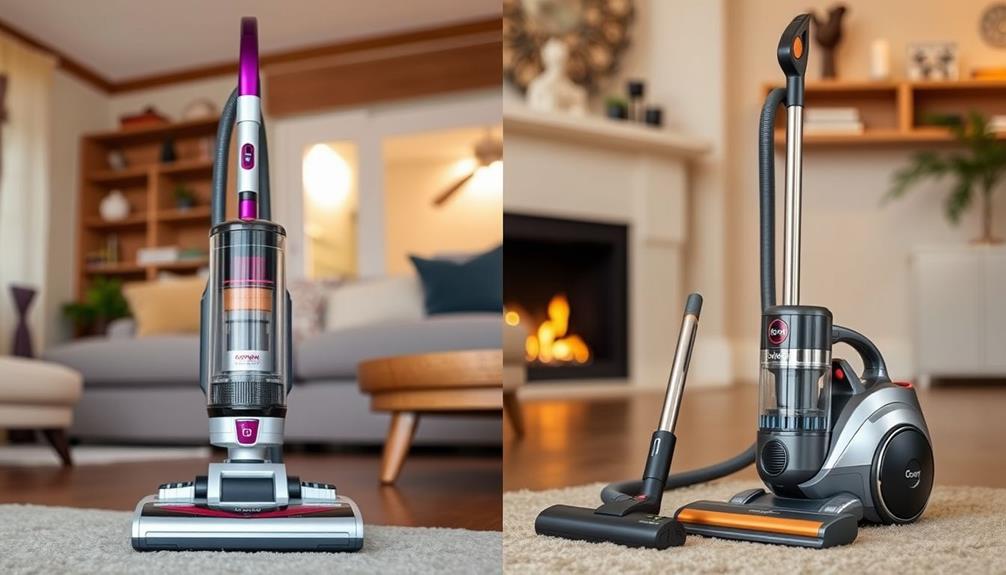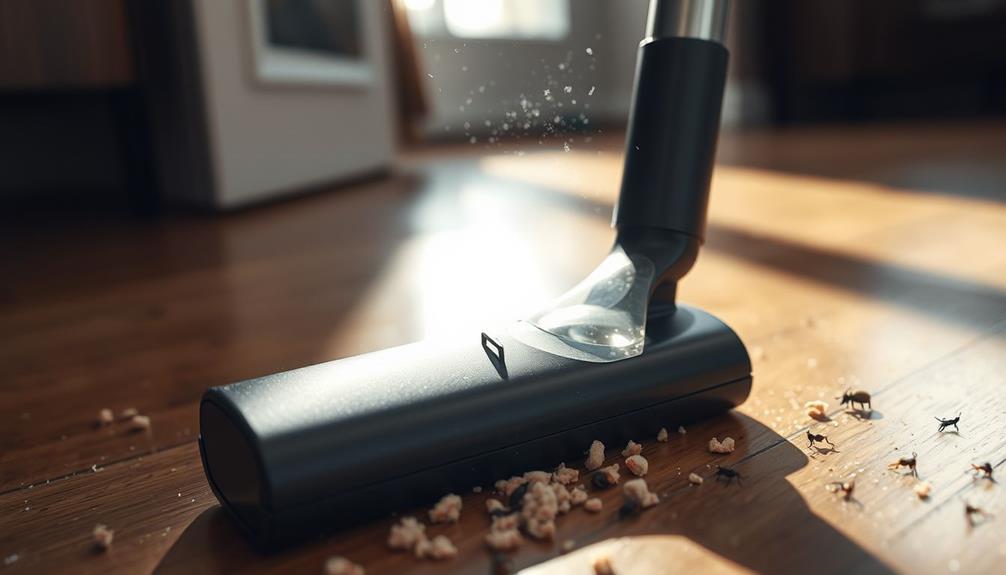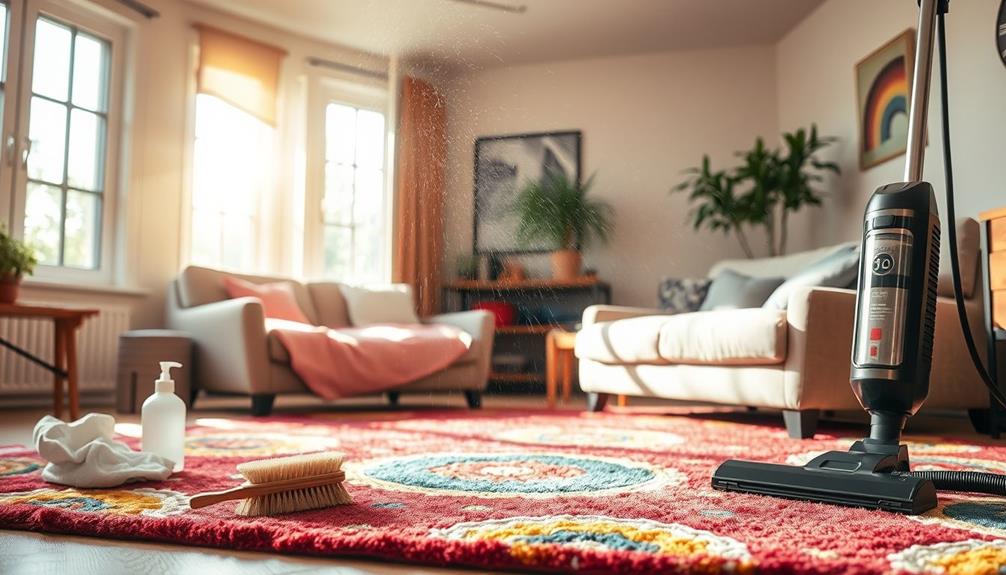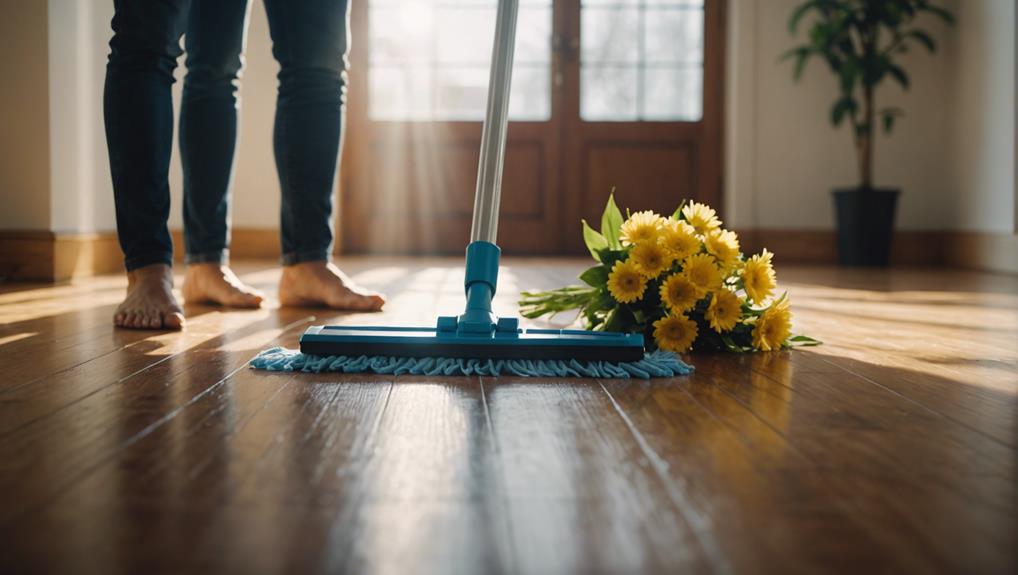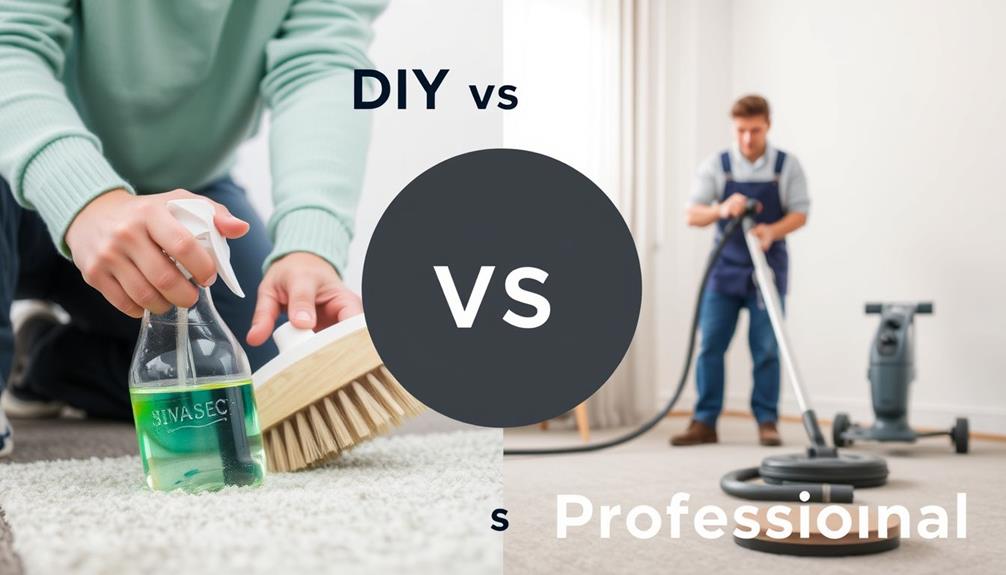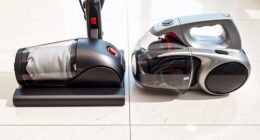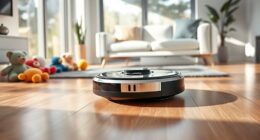When deciding between upright and canister vacuums, consider your cleaning needs. Uprights work well on large carpeted areas and are convenient, but they can be bulky and loud. Canister vacuums, on the other hand, provide better maneuverability in tight spaces and are quieter, making them perfect for a variety of surfaces, such as bare floors and furniture. If you often clean stairs or corners, a canister may be more suitable. However, if you have large areas to clean quickly, an upright might be the better option. Discover more about the unique advantages that can assist you in making a decision.
Key Takeaways
- Cleaning Area: Choose upright vacuums for large carpeted areas; canisters excel in tight spaces and on various surfaces including bare floors and upholstery.
- Noise Levels: Canister vacuums operate quieter (60-65 decibels), making them ideal for noise-sensitive environments, while uprights average 70 decibels.
- Maneuverability: Canister vacuums offer superior flexibility with hoses and wands, perfect for corners and stairs, whereas uprights can be bulkier and less maneuverable.
- Weight Consideration: Canister vacuums are typically lighter, reducing fatigue during extended cleaning sessions compared to heavier upright models.
- Dustbin Capacity: Canister vacuums usually have larger dustbins for longer cleaning without interruptions, while uprights may require more frequent emptying.
Overview of Vacuum Types
When it comes to choosing a vacuum, understanding the differences between upright and canister models can make all the difference for your cleaning routine.
Upright vacuums are designed as all-in-one units, making them user-friendly and efficient for larger carpeted areas due to their wide cleaning path. They're great for quick cleanups and require minimal setup, so you can get right to work.
Many upright vacuums, like the BISSELL CleanView Swivel Upright, offer budget-friendly options that provide effective performance without high costs.
On the other hand, canister vacuums feature a separate motor and dirt container from the handle and power head, allowing for greater maneuverability, especially in tight spaces and on stairs.
If your home has a mix of surfaces, canister vacuums excel at suction power on bare floors and upholstery, often outperforming upright vacuums.
While upright models generally operate at 65-70 decibels, canisters are quieter, operating around 60-65 decibels, which can make a significant difference during cleaning sessions.
Ultimately, the choice between these two types hinges on your cleaning needs, home layout, and budget considerations.
Advantages of Canister Vacuums
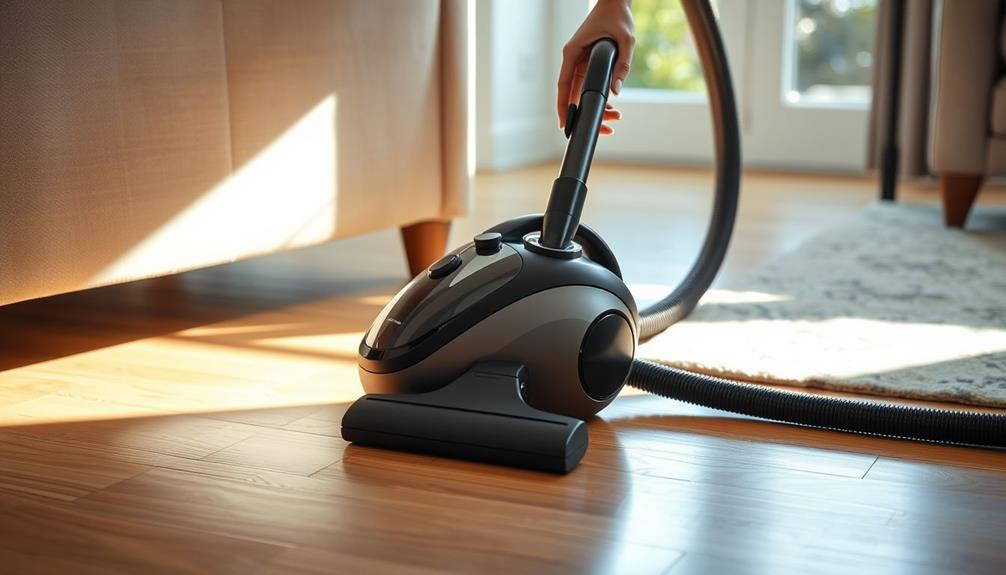
Canister vacuums offer a quieter cleaning experience, operating at lower noise levels that won't disturb your household.
Their lightweight design makes them easy to maneuver, especially in tight spots like stairs or corners.
In addition, some models, like the Bissell Pet Hair Eraser Vacuum, enhance suction power specifically for pet hair removal, making them an excellent choice for pet owners.
With superior suction power and flexible hoses, you can tackle a variety of surfaces effortlessly.
Quieter Operation Benefits
If you're looking to keep the peace while cleaning, you'll find that canister vacuums really shine with their quieter operation. Operating at just 60 to 65 decibels, they're noticeably quieter than upright vacuums, which can reach up to 70 decibels. This makes them ideal for noise-sensitive environments, such as homes with sleeping children or busy professionals.
Additionally, their efficient designs often include features that enhance cleaning without creating excessive noise, making them a top choice for maintaining a tranquil atmosphere. For those considering hiring a home cleaning service, integrating quieter vacuum options can complement the overall cleaning experience.
Here are some key benefits of using canister vacuums for a quieter cleaning experience:
- Reduced Disruption: Their lower noise levels allow you to clean without disturbing others in shared living spaces.
- Pleasant Experience: Insulated motors in canister vacuums minimize operational noise, ensuring a more enjoyable cleaning session.
- Frequent Cleaning: The quieter operation encourages you to clean more often, keeping your space tidy without the hassle of loud noises.
- Lightweight Design: Canister vacuums are easy to maneuver, allowing you to reach tight spots without excessive noise.
With these advantages, you can maintain a clean home while ensuring everyone stays undisturbed. Canister vacuums truly cater to those who value a peaceful atmosphere during cleaning.
Superior Maneuverability Features
Maintaining a quiet cleaning environment is important, but maneuverability is just as critical for effective cleaning. Canister vacuums excel in this area, offering superior maneuverability that makes them perfect for tight spaces and stairs.
Unlike bulky upright vacuum cleaners, canister models are generally lighter, allowing you to navigate around furniture and obstacles with ease. Additionally, their design allows for a smooth, even cleaning experience without the hassle of dragging a heavy unit behind you, similar to the efficiency offered by airless paint sprayers.
Their extended hoses provide the versatility to reach high corners or low areas without having to lift the entire unit, making your cleaning routine more efficient.
Plus, many canister vacuums come with retractable cords, reducing clutter and minimizing tripping hazards while you clean.
With powerful suction capabilities, canister vacuums effortlessly tackle hard-to-reach spots, such as upholstery and crevices, which can be challenging for upright models.
This feature guarantees that you don't miss any dust or dirt hiding in tricky areas.
Disadvantages of Canister Vacuums
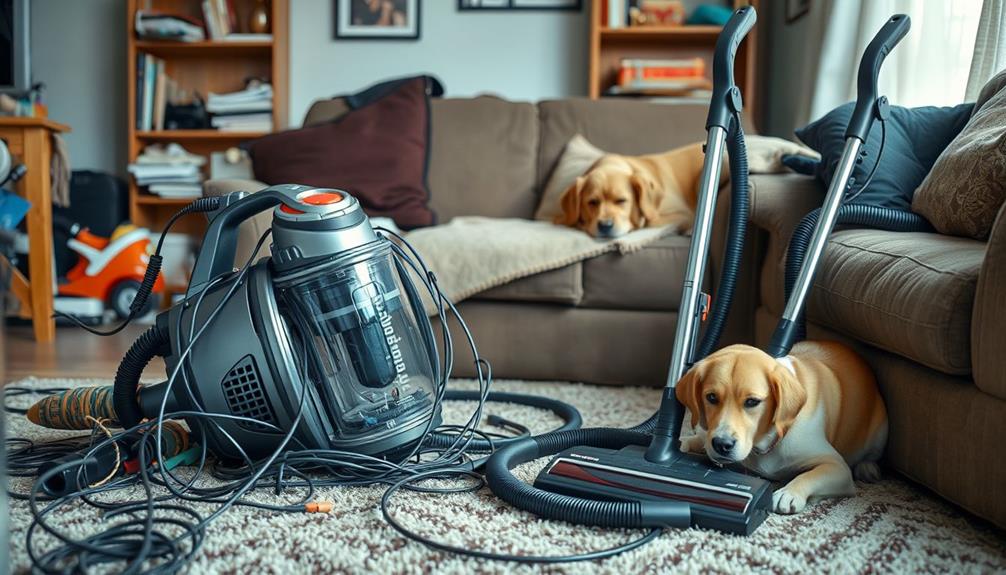
While canister vacuums offer versatility, they come with several disadvantages that can impact your cleaning experience. One notable drawback is that their low design often requires you to bend down during use, which can lead to discomfort or strain over time. Additionally, maintaining a clean environment around the vacuum is vital for efficiency, similar to how air purifier usage guidelines suggest ideal placement and upkeep to enhance performance.
Here are some key drawbacks to take into account:
- Cumbersome Storage: The two-piece design can make it hard to store canister vacs, especially in tight spaces.
- Physical Strain: Their low design often requires you to bend down during use, which can lead to discomfort or strain over time.
- Potential Damage: As you move around, canisters can collide with walls and furniture, causing unsightly scuffs and damage to your surfaces.
- Inconvenient Transport: Transporting the canister across larger rooms can be inconvenient, requiring you to maneuver the unit often.
Though canister vacs are generally lighter than their upright counterparts, it's important to balance the hose and wand effectively for ideal use.
This balancing act can be a challenge for some users, adding to the overall disadvantages. If you're weighing the option of a canister vacuum, keep these points in mind to confirm it fits your cleaning needs and lifestyle.
Advantages of Upright Vacuums

Canister vacuums may have their drawbacks, but upright vacuums bring a host of advantages that can enhance your cleaning routine. One of the standout features of upright vacuums is their user-friendly, one-piece design. This simplifies movement between rooms, making them perfect for quick cleanups when time is of the essence.
With larger vacuum heads, you can cover more ground swiftly, which is particularly beneficial for expansive areas. Additionally, their energy-efficient design can contribute to lower electricity consumption, similar to innovations seen in eco-friendly home solutions.
Another advantage is their budget-friendly price point. Upright vacuums typically cost less than canister models, allowing you to find a reliable cleaning solution without breaking the bank.
Plus, many upright options are bagless, meaning you won't have to deal with the hassle of replacing vacuum bags. Instead, you'll enjoy easy debris disposal and straightforward maintenance.
When it comes to carpet cleaning, upright vacuums excel. They often feature heavy-duty rotating brushes that effectively lift dirt and allergens, ensuring your carpets remain clean and fresh.
With their combination of efficiency, affordability, and effectiveness, upright vacuums are a solid choice for anyone looking to enhance their cleaning experience.
Disadvantages of Upright Vacuums
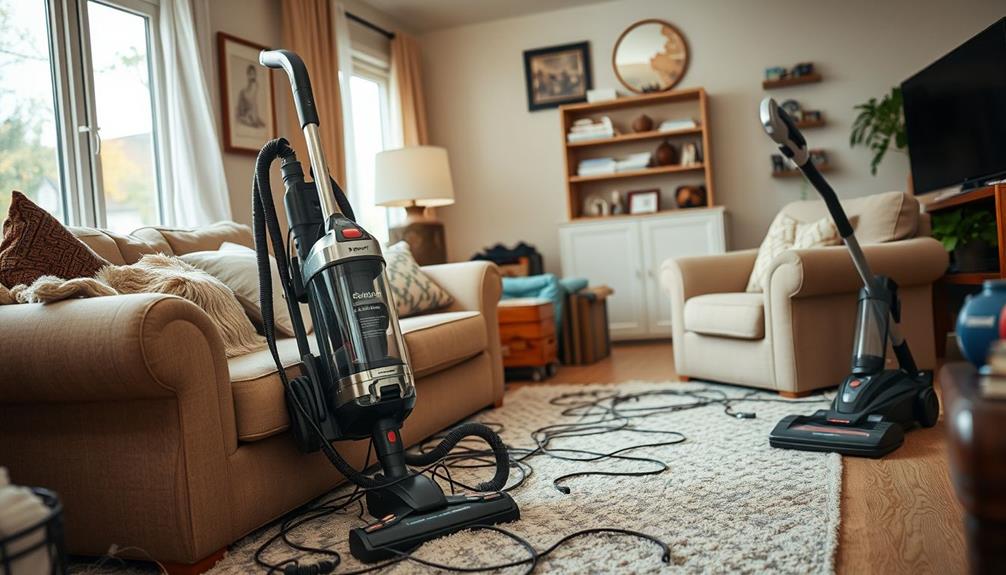
While upright vacuums have their perks, they do come with some notable drawbacks. For instance, their noise levels might be too loud for quiet environments, making them less ideal for use during naptime or late at night.
Additionally, their heavier design can make lengthy cleaning sessions tiring, especially when tackling larger spaces.
Plus, maneuvering them in tight spaces or around corners can be quite a challenge, similar to the difficulties faced with bulky items like garage door openers that require careful navigation in smaller areas.
Noise Level Concerns
Upright vacuums can be quite noisy, averaging around 70 decibels, which often disrupts quiet environments. This noise level can be a significant drawback, especially if you have sleeping children or noise-sensitive adults at home.
Additionally, a serene workspace environment, similar to what one might find in a Cottagecore Home Office, emphasizes the importance of reducing distractions for productivity.
Here are a few reasons why you might want to reconsider using an upright vacuum:
- Disruption: The loud operation can disturb daily activities or peaceful moments.
- Fatigue: The constant noise can lead to fatigue or distraction, making cleaning less efficient.
- Exposed Motors: The design of upright vacuums often features exposed motors that contribute to their increased noise output.
- Comparison to Canister Vacuums: In contrast, canister vacuums operate at lower noise levels, generally between 60-65 decibels, making them a quieter option for residential cleaning.
If you value a peaceful atmosphere while maintaining cleanliness, considering the noise level of your vacuum is essential.
Canister vacuums provide a more tranquil cleaning experience, allowing you to keep your space tidy without the disruptive sounds associated with upright vacuums.
Weight and Fatigue
When it comes to vacuuming, the weight of upright models can quickly become a burden, especially during extended cleaning sessions. Typically weighing 20 lbs or more, these vacuums can lead to significant user fatigue. Incorporating mindful practices about stress management techniques might help alleviate some of the fatigue experienced during cleaning.
You might find yourself feeling exhausted much sooner than you'd with lighter canister vacuums. The bulkier design of uprights not only adds to the weight but also makes maneuvering in tight spaces a challenge, increasing the physical strain on your body.
Moreover, some upright models have a top-heavy design, which can create a sense of unsteadiness while you're vacuuming. This instability requires you to put in extra effort to maintain control, contributing further to fatigue.
If you have mobility challenges or simply prefer a more manageable cleaning experience, the weight of upright vacuums can be a considerable drawback. While they do have their advantages, the toll they take on your energy levels during cleaning might outweigh their convenience, especially if you're tackling larger areas or have multiple floors to clean.
In contrast, canister vacuums often offer a more user-friendly experience, reducing the strain on your body.
Maneuverability Limitations
Cleaning your home can quickly become frustrating if your vacuum struggles to maneuver effectively. Here are some common issues you might face with upright models:
- Weight: Upright vacuums often weigh 20 lbs or more, leading to fatigue during long cleaning sessions. Cats can also be sensitive to loud noises, such as those produced by vacuum cleaners, which may lead to stress or anxiety, similar to how they respond to cat behavior and emotional attachment.
- Size: Their larger size makes it tough to clean corners and under furniture, resulting in missed spots in tight spaces.
- Stairs: The fixed design limits your ability to navigate stairs, making uprights less ideal for multi-level homes.
- Cord Management: Non-retractable cords can tangle and create tripping hazards as you move between rooms.
These maneuverability limitations can really impact your cleaning efficiency.
In contrast, canister vacuum cleaners are often lighter and more versatile, allowing you to glide around furniture and easily tackle stairs.
While upright models excel in open areas, their cumbersome nature in confined spaces can hinder your overall cleaning experience.
If you often deal with tight corners or have multiple levels in your home, considering a canister vacuum might save you the hassle and guarantee a thorough clean.
Suction Power Comparison
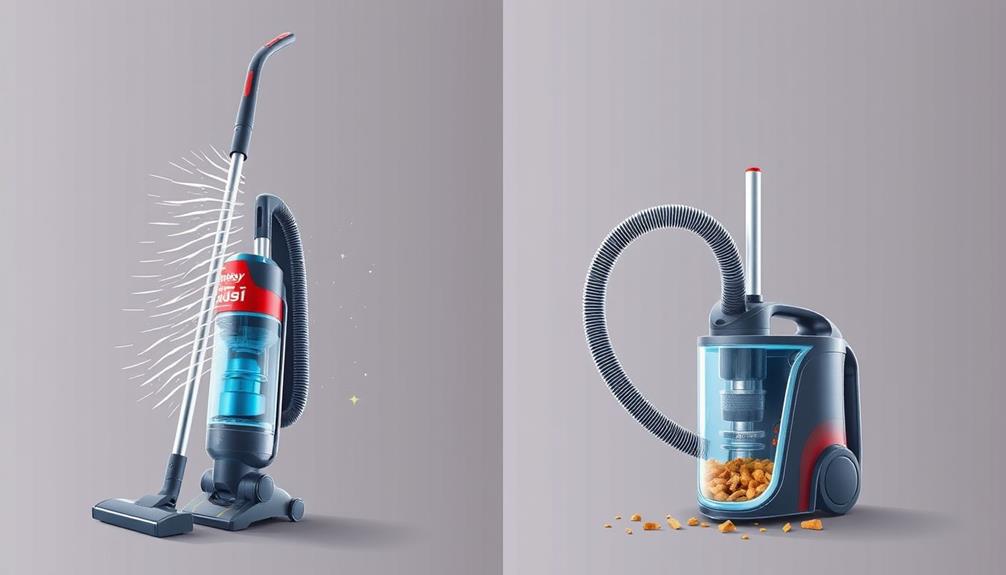
Choosing between upright and canister vacuums often comes down to suction power, which plays a crucial role in cleaning efficiency. Canister vacuums typically offer superior suction power, often exceeding 5,000 mAh, making them highly effective for various surfaces. This enhanced suction allows you to clean hard floors and upholstery with ease, making canister vacuums versatile for different cleaning tasks.
On the other hand, upright vacuums usually range from 2,000 to 3,000 mAh. They excel at deep cleaning carpets thanks to their concentrated suction at floor level and powerful rotating brushes. If your home has extensive carpeted areas, you might find upright vacuums more efficient for that purpose.
However, when it comes to bare floors and detailed cleaning, canister vacuums shine due to their flexibility and ability to reach tight spaces.
It's essential to highlight that while canister vacuums have strong suction, they mightn't be as effective on floors compared to uprights, requiring more effort to maneuver.
Ultimately, your choice should depend on your specific cleaning needs—whether you prioritize suction power for carpets or versatility for various surfaces.
Maneuverability and Weight
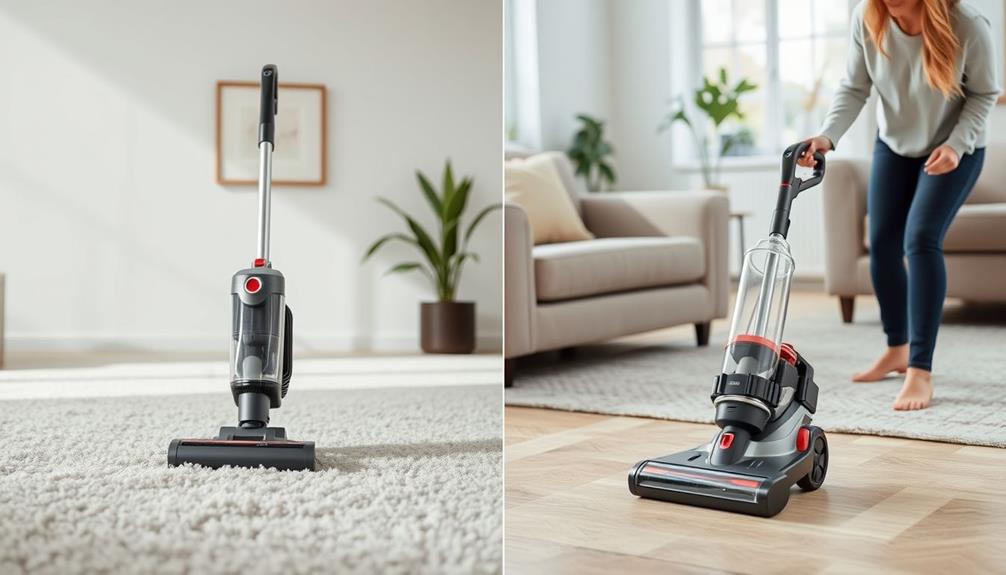
While both upright and canister vacuums have their strengths, canister models often stand out for their superior maneuverability and lightweight design. If you're considering which style suits your needs, here are some points to ponder: When comparing canister vacuums, one important factor to consider is whether you prefer bagged vs bagless vacuums. Bagged canister vacuums tend to hold more dirt and dust, making them a better option for larger homes or those with pets. On the other hand, bagless canister vacuums offer the convenience of not having to purchase replacement bags, making them a more eco-friendly option. Ultimately, the choice between bagged vs bagless vacuums will depend on your personal preferences and cleaning needs.
- Weight: Canister vacuums typically weigh less than uprights, making them easier to handle for extended cleaning sessions.
- Tight Spaces: Their flexible hoses and wands let you clean in corners and reach under furniture with ease.
- Stairs: Canister models excel in maneuverability, allowing you to tackle stairs without straining your back.
- Room Shift: Although uprights have a one-piece design for easy movement between rooms, canisters provide more versatility in tight areas.
In essence, the lightweight design of canister vacuums enhances the user experience considerably.
While some upright models may surprise you with their lighter weight, canisters generally offer more flexibility and ease of use.
If you need a vacuum that can navigate around obstacles and fit into challenging spaces, a canister vacuum might be the smartest choice for you.
Price and Availability
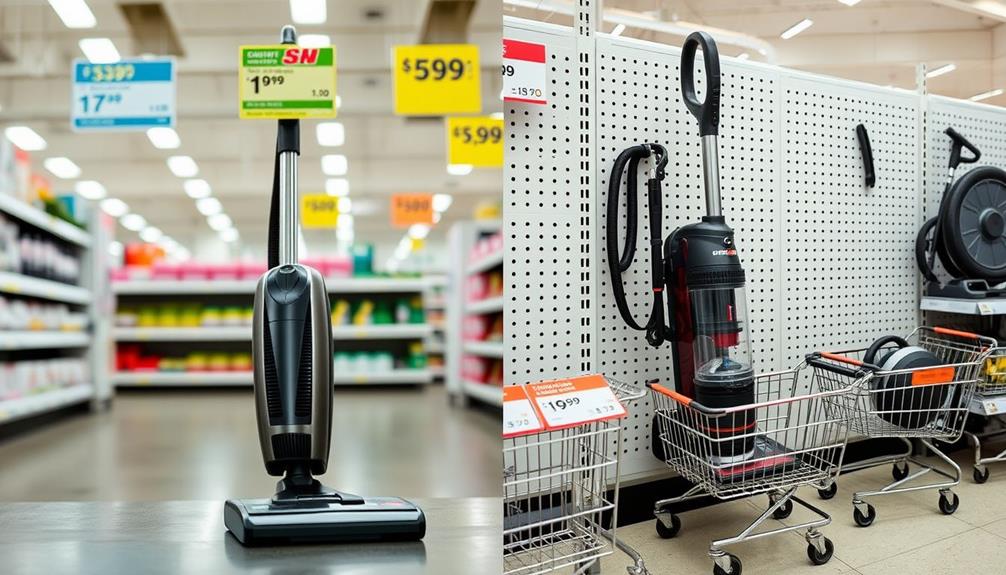
When it comes to price and availability, upright vacuums often have the upper hand. You'll find them in various retail stores, making them a more accessible option for your cleaning needs. The price range for upright vacuums can be quite broad, giving you choices from budget-friendly models to high-end devices. This variety results in competitive pricing, especially since many brands focus on upright models.
Here's a quick comparison to help you visualize the options:
| Type | Average Price Range | Availability |
|---|---|---|
| Budget Upright | $50 – $150 | Widely available |
| Mid-Range Upright | $150 – $300 | Common in stores |
| High-End Upright | $300 and up | Often on promotion |
| Canister Vacuum | $150 – $600 | Less widely available |
| Premium Canister | $600 and up | Limited selections |
The high availability of upright vacuums also leads to more sales promotions and discounts, enhancing affordability. So if you're looking for a vacuum that suits your budget, upright models might be your best bet.
Dustbin Capacity and Features
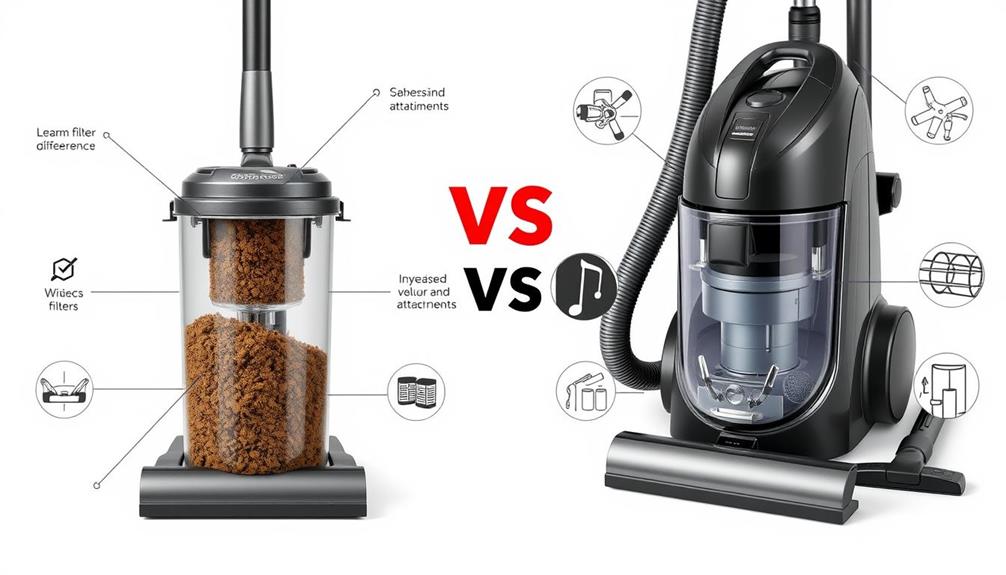
When choosing between upright and canister vacuums, dustbin capacity and features can greatly impact your cleaning experience.
You'll notice that canister models generally offer larger bins and advanced filtration systems, while many uprights provide convenient bagged and bagless options.
Understanding these differences will help you find the vacuum that best suits your maintenance needs and cleaning habits.
Dustbin Size Comparison
Dustbin capacity plays an essential role in determining how efficiently you can tackle cleaning tasks.
When choosing between upright vacuums and canister vacuums, consider the following factors:
- Capacity: Canister vacuums generally have a dust bin capacity that's about 20% larger than upright vacuums, making them ideal for larger areas without frequent emptying.
- Debris Holding: Canister models can hold more debris, allowing for longer cleaning sessions before needing to stop and empty the bin.
- Air Contamination: Many canister vacuums feature refined dust bins that can be pressurized to prevent air contamination during disposal, enhancing your cleaning experience.
- Quick Emptying: Upright vacuums often have dust bins designed for quicker emptying, which can be a lifesaver for urgent cleaning needs.
Ultimately, if you're dealing with extensive cleaning tasks or have larger spaces to manage, canister vacuums may be your best bet.
On the other hand, if you prefer a quicker emptying process and flexibility in dust collection methods, upright vacuums might suit your needs better.
Consider your cleaning habits to choose the right vacuum type for you.
Bagged Vs. Bagless Options
Choosing the right vacuum involves more than just dustbin capacity; it also encompasses whether you prefer bagged or bagless options. Each type has distinct features that cater to your cleaning needs and lifestyle.
| Feature | Bagged | Bagless |
|---|---|---|
| Dustbin Capacity | Generally larger | Usually smaller |
| Maintenance | Requires bag replacement | Regular dustbin cleaning |
| Allergy Control | Better for allergies | May release particles |
| Long-term Cost | Ongoing bag purchases | No bags to buy |
| Convenience | Less frequent emptying | Easy to empty and reuse |
Bagged vacuums typically have a larger dustbin capacity, making them ideal for extensive cleaning tasks. They effectively contain dust and allergens, which is beneficial for allergy sufferers. On the other hand, bagless vacuums allow you to empty the dustbin without buying replacement bags, which can save you money over time. However, they require consistent maintenance to keep the dustbin and filters clean. Ultimately, your choice between bagged and bagless will impact your cleaning routine and maintenance preferences.
Maintenance and Cleaning Ease
Maintaining your vacuum cleaner can greatly impact your cleaning experience, especially regarding dustbin capacity and features. Here's what you should consider:
- Dustbin Size: Canister vacuums typically have larger dustbins, allowing you to clean carpets more extensively before needing to empty.
- Bagless Convenience: Many newer upright models feature bagless designs, making emptying easier and quicker without the hassle of replacing bags.
- Air Contamination Prevention: Canister vacuums often include pressurized dust bins, which help minimize air contamination when you dispose of debris.
- Accessibility: The dustbin location in upright vacuums is generally more accessible, enabling faster emptying in urgent situations.
While canister vacuums might require a bit more maintenance due to their larger capacities and the need for HEPA filter cleaning, their ability to hold more debris can save time in the long run.
On the other hand, if you need something that's easier to move and quick to maintain, an upright vacuum could be the right choice.
Ultimately, consider your cleaning habits and how much maintenance you're willing to commit to when making your decision.
Market Trends and Consumer Preferences
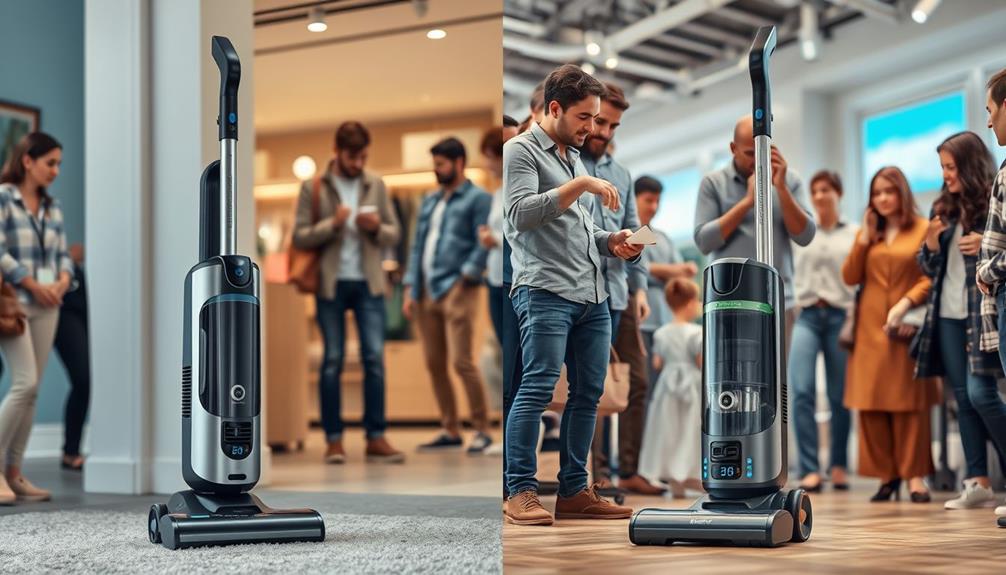
When it comes to market trends, upright vacuums clearly dominate the landscape, outselling canister models by a striking ratio of 3 to 1 in the U.S. This strong consumer preference for upright vacuums often stems from their familiarity and ease of use. Many people stick to what they know, rarely considering canister vacuums until they explore newer models that show their versatility.
While canister vacuums are less popular in the U.S., they're gradually gaining market share thanks to their superior suction power and ability to tackle various cleaning tasks. In contrast, the overall vacuum market is heavily skewed towards uprights, with stick and robot vacuums making up only a small portion of sales.
Interestingly, consumer preferences differ across regions. In England and parts of Europe, the canister vacuum market is stronger, as their design and functionality cater to specific cleaning needs.
As you navigate your cleaning choices, it's crucial to weigh these market trends and preferences against your personal needs to determine which vacuum style is right for you.
Frequently Asked Questions
Do Canister Vacuums Work Better Than Upright?
Canister vacuums often work better for diverse cleaning needs.
They provide superior suction power, making them effective on various surfaces, especially bare floors and upholstery. If you're in a noise-sensitive environment, you'll appreciate their quieter operation.
Plus, their lightweight design allows for easy maneuvering in tight spaces and on stairs. With larger dustbin capacities, you won't need to empty them as frequently, making your cleaning sessions more efficient.
What Are the Disadvantages of a Canister Vacuum?
Using a canister vacuum can feel like wrestling a two-headed snake.
You'll find them cumbersome to store, especially in tight spaces. Operating one means bending over more, which can be uncomfortable during long cleaning sessions.
Plus, the bulky design risks scuffing your walls and furniture. Transporting the canister across rooms isn't always convenient, either.
Maneuvering in tight spots can be a hassle, as balancing the hose and wand can test your patience.
Should I Get an Upright or Stick Vacuum?
When deciding between an upright or stick vacuum, consider your cleaning needs.
If you've got carpets and deep cleaning tasks, an upright may be your best bet due to its powerful suction.
However, if you're looking for something lightweight and portable for quick cleanups or tight spaces, a stick vacuum's cordless design and slim profile could be perfect.
Think about where you'll be using it most, and choose accordingly!
When to Use a Canister Vacuum?
You should use a canister vacuum when tackling stairs or hard-to-reach areas, as their lightweight design makes them easy to carry.
They're perfect for cleaning upholstery and corners, thanks to their flexible hose.
If you have hardwood floors, a canister vacuum's lack of rotating brushes helps prevent scratches.
Plus, their quieter operation is great for noise-sensitive environments, allowing you to clean without disturbing anyone.
Specialized attachments also add to their versatility.
Conclusion
When choosing between upright and canister vacuums, consider your cleaning needs and lifestyle. If you prioritize power and performance, an upright might be your best bet. But if you value versatility and vacuuming in tight spaces, a canister could be the perfect pick. Ultimately, the right vacuum is the one that makes your cleaning chores comfortable and convenient. So, whether you go for the upright or canister, make a choice that fits your fantastic floors!
